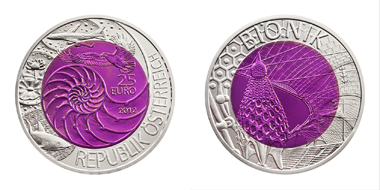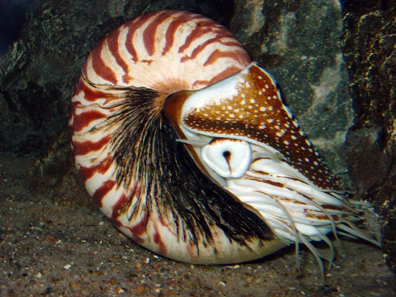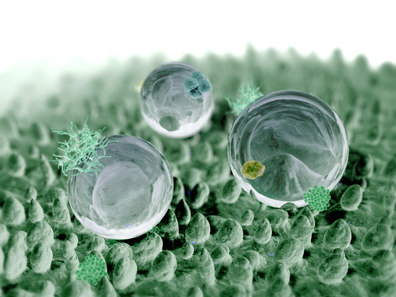February 16, 2012 – The Austrian Mint will issue on February 22, 2012 the tenth coin in the silver niobium bimetallic series featuring Bionics. Bionics is the complex interdisciplinary field in which biological systems and evolution are applied in solving engineering problems and developing modern technology.
The obverse of the coin is dominated by a cross section of the complex nautilus shell, often used as a model for leading edge modern design buildings. Above the nautilus an eagle flies – symbolizing the inspiration for an aircraft. The aircraft also has a special finish on the outer shell, which was based on sharkskin, that reduces friction and thereby allowing the aircraft to fly more efficiently. The lotus flower shown in the left centre of the silver ring gave rise to repellents. The obverse of the coin was deigned by the Mint’s chief engraver Thomas Pesendorfer.
Also on the obverse of the coin and located in the silver ring is the country of issue “Republik Oesterreich,” Republic of Austria and the year of issue 2012. The face value of the coin, 25 euros, is located in the right quadrant of the pure niobium design field.
The reverse side of the coin shows an interior view of the Munich Olympic stadium, the roof of which was designed based on findings in the bionic world based on radiolarian shells. A highly magnified radiolarian shell is shown in the foreground. These shells normally have a size of .1 to .2 mm. Mint engraver Helmut Waehner designed the reverse of this coin.
Jack Steele coined the word “bionics” in 1958. Steele was from Illinois and worked for the US Air Force in the Aerospace Research lab and had studied neurology, psychiatry and anatomy. The word comes form the Greek “bion” meaning unit of life. Many think of the “Bionic Woman” and the “Six Million Dollar Man” from the 1970s and understand the field of bionics to be biology and electronics. In fact, that only covers a part of the broad and complex field. It is the transfer of lessons from nature into the human world. This coin includes many examples of this.
Nautilus shell. Photo: J. Baecker / Wikipedia.
The shell is a perfect example of nature acting as a prototype for modern technology, or bionics.
The nautilus shell is the ultimate in terms of influencing architectural symmetry. The logarithmic perfection of shells leads to three fundamental styles: 1) A circular shape which is found in the winding style of a shell, 2) The spiral which is seen when a shell is viewed from the top and 3) The pyramid, which is seen when a shell is viewed from the side. Three perfect geometric balances all in one compact natural existence. The shell has often been used as inspiration for architecture. The most obvious one is the Sydney Australia Opera House. Complex and able to withstand anything that nature has thus far thrown its way. The entire building flows together.
Enlarged model of the structure of a shark’s skin. Photo: Geri und Freki / Wikipedia.
The skin of a shark is very soft and is made of thousands of teeth-like scales arranged in parallel with the swimming direction. The overlapping teeth-like structure strengthened by riblets in turn reduces drag. This has been known for several decades and has been used to reduce drag on aircraft, ships and even vehicles. Most amazing has been the application of this technology to non-hard surfaces such as swimsuits. The most recent summer Olympic Games held in 2008 in Beijing China resulted in phenomenal results and many new world records were set because of this bionic technology.
Lotus effect. Photo: William Thielicke / Wikipedia.
One of the oldest and best-known transfers from nature to modern technology is the lotus plant. The leaves in particular have a repellent effect on dirt and water. The leaves are rough, microscopically speaking, and do not allow dirt or water to adhere to them; rather they repel dirt, and it is automatically channelled by water off the leaf. This technology based on a natural process has been applied to everything from dirt repellent paints to self-cleaning windows.
Finally, the coin also commemorates the highly valuable understanding of radiolarian structures. These structures have a skeleton that remains very strong despite the many breaks that may occur in the panels that fill-in the skeleton. The complex hexagonal filigree structures of a radiolarian skeleton allow for relatively light weight structures with great strength. Many modern structures and even vehicles from numerous airports such as Shanghai and Denver and even passenger cars such as the Smart Car use radiolarian sophistication to build solid structures.
The new 25-euro coin is issued with a maximum mintage of 65,000 pieces and is struck in special uncirculated quality only. It has a diameter of 34 mm and contains 9 grams of 900 fine silver in the outer ring. The core consists of 7.15 grams of 998 pure niobium and has a striking bright pink color. Each coin is encapsulated, boxed and accompanied by a numbered certificate of authenticity.
You will find the whole niobium coin series on the website of the Austrian Mint.
If you want to see buildings inspired by nature, click here.








